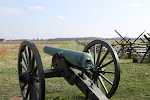Eugene Bunch wasn’t just a train
robber. He was “jovial, jolly and gay –
a typical bandit, who thought his profession of road agent a brave and proper
one,” according to the railroad detectives who chased after him. He reportedly tipped his hat to female train
passengers and declined to take their handbags. He was equally courteous to his
male victims but did relieve them of their wallets. Express agents noted he never raised his
voice when he threatened to blow their heads off if they didn’t open their
safes. His take from a host of robberies was estimated in the hundreds of
thousands of dollars.
For five years, from 1887 to 1892, Bunch
stayed a jump ahead of a bevy of railroad detectives as he robbed trains in
Texas, Louisiana, Mississippi, Georgia, and Florida. His home
in Washington Parish near the Pearl River provided plenty of remote hiding
spots if the law got too close.
 Eugene F. Bunch was born in Mississippi in
1843 to well-respected parents. The family moved to Tangipahoa Parish in his
youth and ensured he received a good education. During the Civil War, he
enlisted in the 3rd Louisiana Cavalry and apparently served well in the
campaigns around Baton Rouge and Port Hudson, although he developed serious
drinking and gambling habits.
Eugene F. Bunch was born in Mississippi in
1843 to well-respected parents. The family moved to Tangipahoa Parish in his
youth and ensured he received a good education. During the Civil War, he
enlisted in the 3rd Louisiana Cavalry and apparently served well in the
campaigns around Baton Rouge and Port Hudson, although he developed serious
drinking and gambling habits.
At the close of the war Bunch returned to
Tangipahoa Parish and opened a school at Amite. He married a Louisiana girl,
Flavia Flynn, in 1869. School teaching
didn’t agree with him—probably because of his excessive drinking—so Bunch
loaded up his pregnant wife and moved to Gainesville, Texas in 1874.
Bunch taught school briefly in Gainesville
before being elected to three consecutive two-year terms as the Cooke County clerk. He apparently used his position as an insider




















